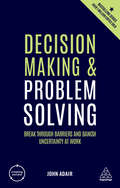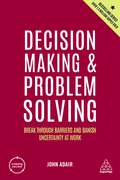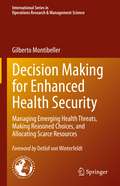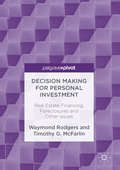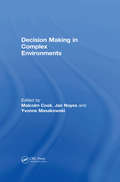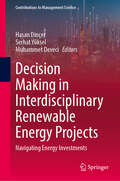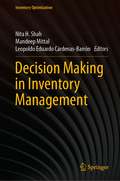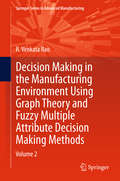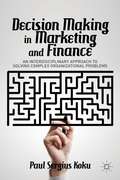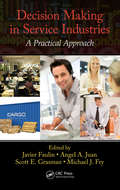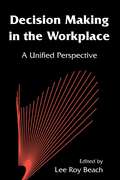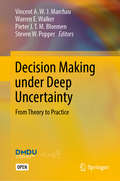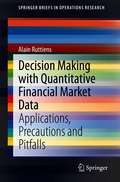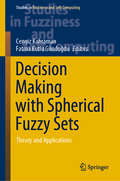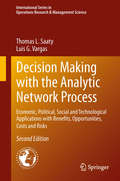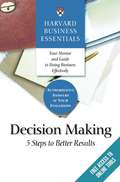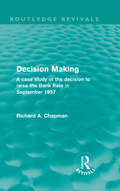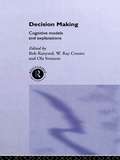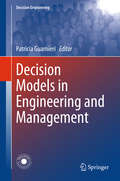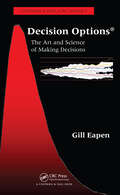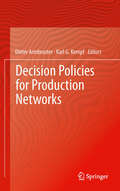- Table View
- List View
Decision Making and Problem Solving: Break Through Barriers and Banish Uncertainty at Work (Creating Success #66)
by John AdairIn Decision Making and Problem Solving, leadership guru John Adair provides the techniques and insights you need to find solutions, spark creativity and confidently make the right decisions. Fully updated for 2019, this 4th edition now features even more practical exercises, useful templates, and top tips to provide a clear framework that can generate ideas and inspire confidence in your team - so you can spot the solution in every problem, and create ideas to rival even the best strategists.The Creating Success series of books...Unlock vital skills, power up your performance and get ahead with the bestselling Creating Success series. Written by experts for new and aspiring managers and leaders, this million-selling collection of accessible and empowering guides will get you up to speed in no time. Packed with clever thinking, smart advice and the kind of winning techniques that really get results, you'll make fast progress, quickly reach your goals and create lasting success in your career.
Decision Making and Problem Solving: Break Through Barriers and Banish Uncertainty at Work (Creating Success #8)
by John AdairThought leader John Adair provides the techniques and insights you need to find solutions, spark creativity and confidently make the right decisions. This 5th edition now features even more practical exercises, useful templates, and top tips to provide a clear framework that can generate ideas and inspire confidence in your team - so you can spot the solution in every problem, and create ideas to rival even the best strategists.The Creating Success series of books...Unlock vital skills, power up your performance and get ahead with the bestselling Creating Success series. Written by experts for new and aspiring managers and leaders, this million-selling collection of accessible and empowering guides will get you up to speed in no time. Packed with clever thinking, smart advice and the kind of winning techniques that really get results, you'll make fast progress, quickly reach your goals and create lasting success in your career.
Decision Making as Leadership Foundation
by Michael UseemAll organizations have an interest in ensuring that their leaders make good and timely decisions, but good decision making-so vital to effective leadership-is not a skill that comes naturally to every leader. Studies of what Nobel laureate and noted expert on decision making Daniel Kahneman terms "systemic biases"-the mental flaws that separate the choices leaders actually make from what rational agent models expect-reveal that these biases can be reduced when leaders are trained in decision making and have learned from experience. Both universities and companies bear the responsibility of preparing current and future leaders to make sound decisions in work environments that are often demanding and frequently changing. And given the impact of increasingly global product and equity markets on company operations, the pressures for quality decision making are sure to intensify. The chapter concludes with an examination of how boards of directors make decisions, with rich examples from Boeing (its decision to build the 787 aircraft) and computer technology giant Lenovo (its decision to build a global company). This chapter was originally published as Chapter 18 of "Handbook of Leadership Theory and Practice: A Harvard Business School Centennial Colloquium."
Decision Making as a Learning Activity
by Arie De GeusEvery act of decision making is a learning process. This chapter describes the elements of learning and how understanding the learning process can benefit your company.
Decision Making at the Top: The All-Star Sports Catalog Division
by David A. Garvin Michael A. RobertoDescribes a senior management team's strategic decision-making process. The division president faces three options for redesigning the process to address several key concerns. The president has extensive quantitative and qualitative data about the process to guide him as he and the senior team attempt to make improvements.
Decision Making for Enhanced Health Security: Managing Emerging Health Threats, Making Reasoned Choices, and Allocating Scarce Resources (International Series in Operations Research & Management Science #328)
by Gilberto MontibellerHealth threats pose significant dangers to humankind and form a major source of human suffering and sorrow. Responsible leadership and reasoned decision making can significantly improve the arenas that are affected by health threats, through establishing a better allocation of very scarce resources for building health capabilities and for increasing health preparedness, responsiveness and resilience.This book examines how public health leaders can use the cutting-edge research from Decision Sciences to better manage emerging and re-emerging health threats, with a focus on enhancing health security. While these decisions must be informed by the best available evidence, they must also address competing priorities and key uncertainties and must mitigate critical risks, albeit in a cost-effective manner which seeks to maximize societal value.This is a book about how decisions on health security can be improved, both in terms of the content that is utilized in a health decision analysis and the decision processes that are employed in reaching a decision. This decision-focused perspective can help public health leaders and public health experts to increase the health preparedness of health systems, the task of which involves improving health capabilities, increasing the robustness of health systems against health threats, as well as strengthening health resilience and the responsiveness of these systems against disease outbreaks.
Decision Making for Personal Investment
by Waymond Rodgers Timothy G. McfarlinThis book presents a personal financial decision making model based on six dominant decision making pathways. It outlines each pathway in detail before focusing on real estate investments in the second part of the book. Based on the authors extensive research into investment decision making, decision modeling and experimental psychology, strategies presented in this book will facilitate more successful investment decision making.
Decision Making in Complex Environments
by Malcolm Cook Jan Noyes Yvonne MasakowskiMany complex systems in civil and military operations are highly automated with the intention of supporting human performance in difficult cognitive tasks. The complex systems can involve teams or individuals working on real-time supervisory control, command or information management tasks where a number of constraints must be satisfied. Decision Making in Complex Environments addresses the role of the human, the technology and the processes in complex socio-technical and technological systems. The aim of the book is to apply a multi-disciplinary perspective to the examination of the human factors in complex decision making. It contains more than 30 contributions on key subjects such as military human factors, team decision making issues, situation awareness, and technology support. In addition to the major application area of military human factors there are chapters on business, medical, governmental and aeronautical decision making. The book provides a unique blend of expertise from psychology, human factors, industry, commercial environments, the military, computer science, organizational psychology and training that should be valuable to academics and practitioners alike.
Decision Making in Interdisciplinary Renewable Energy Projects: Navigating Energy Investments (Contributions to Management Science)
by Hasan Dinçer Serhat Yüksel Muhammet DeveciThis edited book presents a comprehensive analysis of the multidimensional aspects associated with decision making in renewable energy investment projects. It delves into the interplay between interdisciplinary studies, sustainability considerations, and circular economy principles within the renewable energy sector. By examining the impact of these interconnected domains, the book offers valuable insights into the challenges and opportunities inherent in decision making for renewable energy investments. The book is tailored to a diverse audience, including researchers, scholars, and professionals in the fields of renewable energy, sustainability, circular economy, and business management. It is equally suitable for graduate and undergraduate students studying environmental studies, renewable energy, sustainability, and related disciplines. Professionals working in the renewable energy industry, including project developers, investors, and policymakers, will find valuable insights to inform their decision-making processes. Additionally, engineers, economists, social scientists, and environmental consultants interested in interdisciplinary studies and their intersection with renewable energy will benefit from the book's comprehensive analysis.
Decision Making in Inventory Management (Inventory Optimization)
by Nita H. Shah Mandeep Mittal Leopoldo Eduardo Cárdenas-BarrónThis book provides several inventory models for making the right decision in inventory management under different environments. Basically, the optimal ordering policies are determined for situations with and without shortages in production-inventory systems. The chapters in the book include various features of inventory modeling i.e., inflation, deterioration, supply chain, learning, credit financing, carbon emission policy, stock-dependent demand, among others. The book is a useful resource for academicians, researchers, students, practitioners, and managers who can be benefited with the policies provided in the chapters of the book.
Decision Making in Manufacturing Environment Using Graph Theory and Fuzzy Multiple Attribute Decision Making Methods
by R. Venkata RaoDecision Making in Manufacturing Environment Using Graph Theory and Fuzzy Multiple Attribute Decision Making Methods presents the concepts and details of applications of MADM methods. A range of methods are covered including Analytic Hierarchy Process (AHP), Technique for Order Preference by Similarity to Ideal Solution (TOPSIS), VIšekriterijumsko KOmpromisno Rangiranje (VIKOR), Data Envelopment Analysis (DEA), Preference Ranking METHod for Enrichment Evaluations (PROMETHEE), ELimination Et Choix Traduisant la Realité (ELECTRE), COmplex PRoportional ASsessment (COPRAS), Grey Relational Analysis (GRA), UTility Additive (UTA), and Ordered Weighted Averaging (OWA). The existing MADM methods are improved upon and three novel multiple attribute decision making methods for solving the decision making problems of the manufacturing environment are proposed. The concept of integrated weights is introduced in the proposed subjective and objective integrated weights (SOIW) method and the weighted Euclidean distance based approach (WEDBA) to consider both the decision maker's subjective preferences as well as the distribution of the attributes data of the decision matrix. These methods, which use fuzzy logic to convert the qualitative attributes into the quantitative attributes, are supported by various real-world application examples. Also, computer codes for AHP, TOPSIS, DEA, PROMETHEE, ELECTRE, COPRAS, and SOIW methods are included. This comprehensive coverage makes Decision Making in Manufacturing Environment Using Graph Theory and Fuzzy Multiple Attribute Decision Making Methods a key reference for the designers, manufacturing engineers, practitioners, managers, institutes involved in both design and manufacturing related projects. It is also an ideal study resource for applied research workers, academicians, and students in mechanical and industrial engineering.
Decision Making in Marketing and Finance
by Paul Sergius KokuAs interest in MBA programs and business schools more generally continues to grow, it is essential that teachers and students analyse their established strategy for decision making. The successful use of case studies in business schools shows the superior outcomes of an interdisciplinary approach to problem solving. Disappointingly, functional departmental silos within universities still exist and keep problem solvers from seeing all the effects of a given issue. In addition to providing teaching material, Decision Making in Marketing and Finance provides motives and strategies to break down functional silos in making informed and effective business and finance decisions. Koku achieves his goal by showing how value can be created for shareholders and other stakeholders, linking marketing and finance decision making, and providing much-needed teaching materials for an interdisciplinary approach to case analysis.
Decision Making in Service Industries: A Practical Approach
by Javier Faulin Angel A. Juan Michael J. Fry Scott E. GrasmanIn real-life scenarios, service management involves complex decision-making processes usually affected by random or stochastic variables. Under such uncertain conditions, the development and use of robust and flexible strategies, algorithms, and methods can provide the quantitative information necessary to make better business decisions. Decision M
Decision Making in the Workplace: A Unified Perspective
by Lee Roy BeachMany, if not most, of one's important decisions are made in the context of one's work. However, because workplace decisions cover such a broad range of issues, it often is difficult to detect underlying commonalities in how they are made, and in how things go wrong when they do go wrong. As a result, there are nearly as many different descriptions of workplace decisions as there are decisions themselves. In this volume, the best features of these diverse descriptions are unified in a new, intuitively compelling view of decision making called "Image Theory." The result is a clear picture of real-life, day-to-day workplace decision making that allows us to think constructively about how such decisions are made and about how to improve them when improvement is necessary.
Decision Making under Deep Uncertainty: From Theory To Practice
by Steven W. Popper Warren E. Walker Vincent A. W. J. Marchau Pieter J. T. M. BloemenThis open access book focuses on both the theory and practice associated with the tools and approaches for decisionmaking in the face of deep uncertainty. It explores approaches and tools supporting the design of strategic plans under deep uncertainty, and their testing in the real world, including barriers and enablers for their use in practice. The book broadens traditional approaches and tools to include the analysis of actors and networks related to the problem at hand. It also shows how lessons learned in the application process can be used to improve the approaches and tools used in the design process. The book offers guidance in identifying and applying appropriate approaches and tools to design plans, as well as advice on implementing these plans in the real world. For decisionmakers and practitioners, the book includes realistic examples and practical guidelines that should help them understand what decisionmaking under deep uncertainty is and how it may be of assistance to them. <p><p> Decision Making under Deep Uncertainty: From Theory to Practice is divided into four parts. Part I presents five approaches for designing strategic plans under deep uncertainty: Robust Decision Making, Dynamic Adaptive Planning, Dynamic Adaptive Policy Pathways, Info-Gap Decision Theory, and Engineering Options Analysis. Each approach is worked out in terms of its theoretical foundations, methodological steps to follow when using the approach, latest methodological insights, and challenges for improvement. In Part II, applications of each of these approaches are presented. Based on recent case studies, the practical implications of applying each approach are discussed in depth. Part III focuses on using the approaches and tools in real-world contexts, based on insights from real-world cases. Part IV contains conclusions and a synthesis of the lessons that can be drawn for designing, applying, and implementing strategic plans under deep uncertainty, as well as recommendations for future work.
Decision Making with Quantitative Financial Market Data: Applications, Precautions and Pitfalls (SpringerBriefs in Operations Research)
by Alain RuttiensUse of quantitative data, especially in financial markets, may provide rapid results due to the ease-of-use and availability of fast computational software, but this book advises caution and helps to understand and avoid potential pitfalls.It deals with often underestimated issues related to the use of financial quantitative data, such as non-stationarity issues, accuracy issues and modeling issues. It provides practical remedies or ways to develop new calculation methodologies to avoid pitfalls in using data, as well as solutions for risk management issues in financial market. The book is intended to help professionals in financial industry to use quantitative data in a safer way.
Decision Making with Spherical Fuzzy Sets: Theory and Applications (Studies in Fuzziness and Soft Computing #392)
by Cengiz Kahraman Fatma Kutlu GündoğduThis book introduces readers to the novel concept of spherical fuzzy sets, showing how these sets can be applied in practice to solve various decision-making problems. It also demonstrates that these sets provide a larger preference volume in 3D space for decision-makers. Written by authoritative researchers, the various chapters cover a large amount of theoretical and practical information, allowing readers to gain an extensive understanding of both the fundamentals and applications of spherical fuzzy sets in intelligent decision-making and mathematical programming.
Decision Making with the Analytic Network Process
by Thomas L. Saaty Luis G. VargasThe Analytic Network Process (ANP), developed by Thomas Saaty in his work on multicriteria decision making, applies network structures with dependence and feedback to complex decision making. This new edition of Decision Making with the Analytic Network Process is a selection of the latest applications of ANP to economic, social and political decisions, and also to technological design. The ANP is a methodological tool that is helpful to organize knowledge and thinking, elicit judgments registered in both in memory and in feelings, quantify the judgments and derive priorities from them, and finally synthesize these diverse priorities into a single mathematically and logically justifiable overall outcome. In the process of deriving this outcome, the ANP also allows for the representation and synthesis of diverse opinions in the midst of discussion and debate. The book focuses on the application of the ANP in three different areas: economics, the social sciences and the linking of measurement with human values. Economists can use the ANP for an alternate approach for dealing with economic problems than the usual mathematical models on which economics bases its quantitative thinking. For psychologists, sociologists and political scientists, the ANP offers the methodology they have sought for some time to quantify and derive measurements for intangibles. Finally the book applies the ANP to provide people in the physical and engineering sciences with a quantitative method to link hard measurement to human values. In such a process, one is able to interpret the true meaning of measurements made on a uniform scale using a unit.
Decision Making: 5 Steps To Better Results (Harvard Business Essentials)
by Harvard Business School Press StaffDecision making is a critical part of management, and bad choices can damage careers and the bottom line. This book offers the tools and advice managers need to avoid common biases and arrive at and implement decisions that are both sound and ethical. The Harvard Business Essentials series provides comprehensive advice, personal coaching, background information, and guidance on the most relevant topics in business. Whether you are a new manager seeking to expand your skills or a seasoned professional looking to broaden your knowledge base, these solution-oriented books put reliable answers at your fingertips.
Decision Making: A case study of the decision to raise the Bank Rate in September 1957 (Routledge Revivals)
by Richard A. ChapmanOriginally published in 1968, Richard Chapman’s pioneering work illuminates the process of decision making by analysis of a particular example: the decision to raise the Bank Rate in September, 1957. The legal responsibility for a decision may be easy to pinpoint; in this case the Court of Directors of the Bank of England bear this but six weeks of negotiation separate their formal statement from the Chancellor of the Exchequer’s advice to the Treasury to consider effecting ‘a measure of deflation in the economy’. These six weeks of consultation between the Bank and the Treasury proceeding in ‘the pattern of a formal dance’ are analysed and a necessary by-product of this case-study is a closer understanding of how the Treasury and the Bank of England work together. These details are derived mainly from the evidence, and deductions from it, presented to the Bank Rate Tribunal and the Radcliffe Committee on the Working of the Monetary System. Professor Chapman gives his particular findings about decision making a wider application still by forming reasoned hypotheses and informed generalisations about public administration in Britain.
Decision Making: Cognitive Models and Explanations (Frontiers of Cognitive Science #Vol. 1)
by W. Ray Crozier Rob Ranyard Ola SvensonThis book offers an exciting new collection of recent research on the actual processes that humans use when making decisions in their everyday lives and in business situations. The contributors use cognitive psychological techniques to break down the constituent processes and set them in their social context. The contributors are from many different countries and draw upon a wide range of techniques, making this book a valuable resource to cognitive psychologists in applied settings, economists and managers.
Decision Models in Engineering and Management
by Patricia GuarnieriProviding a comprehensive overview of various methods and applications in decision engineering, this book presents chapters written by a range experts in the field. It presents conceptual aspects of decision support applications in various areas including finance, vendor selection, construction, process management, water management and energy, agribusiness , production scheduling and control, and waste management. In addition to this, a special focus is given to methods of multi-criteria decision analysis. Decision making in organizations is a recurrent theme and is essential for business continuity. Managers from various fields including public, private, industrial, trading or service sectors are required to make decisions. Consequently managers need the support of these structured methods in order to engage in effective decision making. This book provides a valuable resource for graduate students, professors and researchers of decision analysis, multi-criteria decision analysis and group decision analysis. It is also intended for production engineers, civil engineers and engineering consultants.
Decision Options: The Art and Science of Making Decisions (Chapman & Hall/CRC Finance Series)
by Gill EapenThrough theory and case studies, this book details how uncertainty and flexibility can be evaluated to assist in making better investment decisions in companies. It delivers an excellent balance of theory and practice in the area of investment decision making, demonstrates how financial and real options are related, and describes the theoretical underpinnings of both. The author presents case studies from diverse industries, including life sciences, pharmaceuticals, commodities, energy, technology, manufacturing, and financial services. He also looks at how organizations can become successful using a holistic framework that integrates uncertainty and flexibility.
Decision Policies for Production Networks
by Dieter Armbruster Karl G. KempfThe financial results of any manufacturing company can be dramatically impacted by the repetitive decisions required to control a complex production network be it a network of machines in a factory; a network of factories in a company; or a network of companies in a supply chain. Decision Policies for Production Networks presents recent convergent research on developing policies for operating production networks including details of practical control and decision techniques which can be applied to improve the effectiveness and economic efficiency of production networks worldwide. Researchers and practitioners come together to explore a wide variety of approaches to a range of topics including: WIP and equipment management policies, Material release policies, Machine, factory, and supply chain network policies for delivery in the face of supply and demand variability, and Conflicts between complex production network models and their controlling policies. Case studies and relevant mathematical techniques are included to support and explain techniques such as heuristics, global and hierarchical optimization, control theory and filtering approaches related to complex systems or traffic flows. Decision Policies for Production Networks acts as handbook for researchers and practitioners alike, providing findings and information which can be applied to develop methods and advance further research across production networks.
Decision Process: Five Key Steps
by Richard LueckeThis chapter illustrates how you can organize the decision-making process into five simple steps. Using these techniques reveals the pros, cons, risks, and trade-offs of any given decision.
